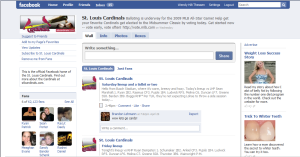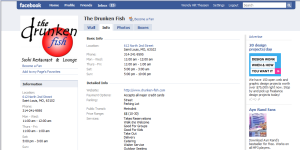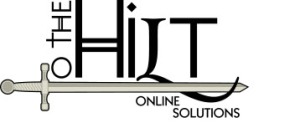When you started your business–think back, did you put up a tent and a hand-painted sign and wait for the customers to flock to you? Probably not. Every business plan should have a marketing strategy, but many do not. Owners think through location, build-out, signage,  phone systems, compensation, and a host of other things that make a business successful. If you are a business owner, you know how much work it is to get everything working, and yet asking customers to come to you and telling them why often takes a backseat to all these other concerns.
phone systems, compensation, and a host of other things that make a business successful. If you are a business owner, you know how much work it is to get everything working, and yet asking customers to come to you and telling them why often takes a backseat to all these other concerns.
Marketing is often the first expense to be cut. Please note that I said “expense” instead of “investment.” If your marketing is simply an expense–Cut it! If it is a clear plan working consistently on several levels that brings you business and builds your brand (Business reputation) then it is a true investment. It doesn’t matter is your business is brand new or has been around for generations. All businesses need marketing. All businesses need a marketing plan, especially one that reaches today’s participatory consumers.
The newspaper mentality has always been, you must be in the paper. Really? Not so! Today’s consumers have changed their media habits and advertising must change in order to reach your customers. Are there some that still read the paper, yes, but only some.
The same thing was true of Yellow Pages listings…You must be in the Yellow Pages! It’s a huge monthly investment, but consumers used to go there to look at your business, often overshadowed by your competitor’s ads stacked right together. Some people use the directories still, but the percentage is waning. Today’s directory is more likely to be Google or Bing–and it’s free to list there! True!
The point is, make your marketing count! It’s your money. It’s your business. It’s your reputation. You aren’t in business just to see if it might work for a few weeks. Invest some time with a marketer who understands what your vision for the business is. Invest a percentage of your gross toward advertising because it can become the life-blood of your business. (Another topic for another day.) Don’t overlook the impact your business can have from simple online platforms or shy away because you don’t understand it. A good full-service marketer will teach you the basics and do the rest for you. Know that your negotiation power has never been greater that it is in marketing right now. Online platforms can be purchased by geographic slices (Williamson County businesses can target Williamson County residents.) Working with online can be incredibly inexpensive and trackable. Tradional media is aware of online, but to date have not been able to tap online to deliver results. Traditional media is simply what we’ve always known: radio, television, billboard, newspaper. The new media is everything else that people interact with each and every day. At To the Hilt Marketing we call it “participatory media,” and there are hundreds of ways to market to both the traditional market and the participatory market. Managing your online presense and your mass media presense together will show your customers that you are a strong business with a vision for the future.
To schedule a consultation that will help you examine both just send us an email to: info@TotheHiltOnline.com




 After the virginity of the prepared canvas has been broken the strokes, right or wrong are much easier. It’s the layering of the paint that makes the image art. I know that. Learned that a long time ago. Yet, every time I prepare my paints and brushes, take a seat in a well-lit room and stare at that stark white canvas. I cannot think of many times that I’ve looked at the end result and been disappointed. I can think of many times I looked away and got busy with other things rather than make that first stroke.
After the virginity of the prepared canvas has been broken the strokes, right or wrong are much easier. It’s the layering of the paint that makes the image art. I know that. Learned that a long time ago. Yet, every time I prepare my paints and brushes, take a seat in a well-lit room and stare at that stark white canvas. I cannot think of many times that I’ve looked at the end result and been disappointed. I can think of many times I looked away and got busy with other things rather than make that first stroke.
 listening to Casey Kasem, making cassette tapes of our favorite music. I remember listening to the radio all the time. All baseball games were not televised, niether were football–we listened because our team might not be the one or two featured games of the week. We had less money and as a result we had less music of our own.
listening to Casey Kasem, making cassette tapes of our favorite music. I remember listening to the radio all the time. All baseball games were not televised, niether were football–we listened because our team might not be the one or two featured games of the week. We had less money and as a result we had less music of our own. same? I think not.
same? I think not. gle. They use media differently than we do. They think differently than we do. When you say mouse, they think of a computer device…not a rodent.
gle. They use media differently than we do. They think differently than we do. When you say mouse, they think of a computer device…not a rodent. The consumer has changed. Has your marketing? Using online advertising gives businesses the opportunity to interact with consumers in ways they never could before. In the past, advertising has always been a one-way conversation: Company Message—-to—Consumer. Tradional media interupts your life and forces you to listen to the message, often with force, comedy, yelling, shock. As a result, the consumer no longer trusts advertising the same way they did in the past. Do you?
The consumer has changed. Has your marketing? Using online advertising gives businesses the opportunity to interact with consumers in ways they never could before. In the past, advertising has always been a one-way conversation: Company Message—-to—Consumer. Tradional media interupts your life and forces you to listen to the message, often with force, comedy, yelling, shock. As a result, the consumer no longer trusts advertising the same way they did in the past. Do you?